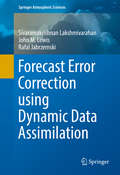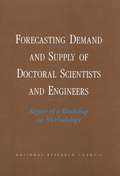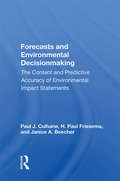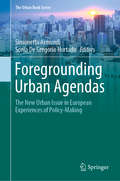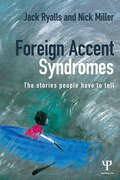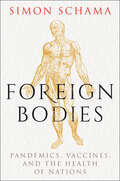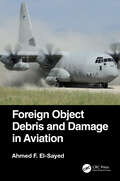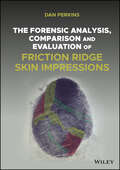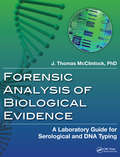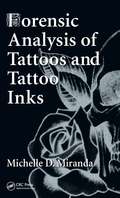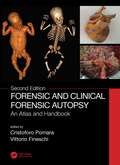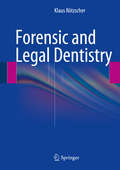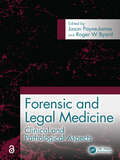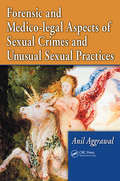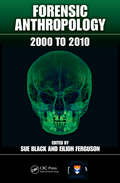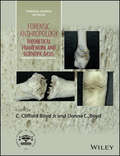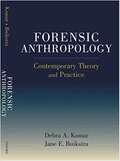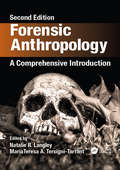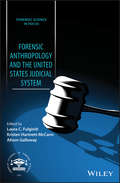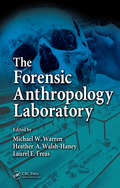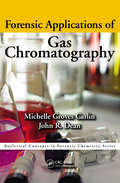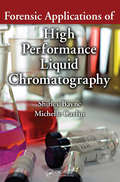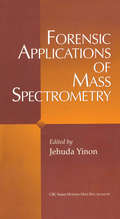- Table View
- List View
Forecast Error Correction using Dynamic Data Assimilation
by Sivaramakrishnan Lakshmivarahan John M. Lewis Rafal JabrzemskiThis book introduces the reader to a new method of data assimilation with deterministic constraints (exact satisfaction of dynamic constraints)--an optimal assimilation strategy called Forecast Sensitivity Method (FSM), as an alternative to the well-known four-dimensional variational (4D-Var) data assimilation method. 4D-Var works with a forward in time prediction model and a backward in time tangent linear model (TLM). The equivalence of data assimilation via 4D-Var and FSM is proven and problems using low-order dynamics clarify the process of data assimilation by the two methods. The problem of return flow over the Gulf of Mexico that includes upper-air observations and realistic dynamical constraints gives the reader a good idea of how the FSM can be implemented in a real-world situation.
Forecasting Demand and Supply of Doctoral Scientists and Engineers: Report of a Workshop on Methodology
by Office of Scientific Engineering PersonnelThis report is the summary of a workshop conducted by the National Research Council in order to learn from both forecast makers and forecast users about improvements that can be made in understanding the markets for doctoral scientists and engineers. The workshop commissioned papers examined (1) the history and problems with models of demand and supply for scientists and engineers, (2) objectives and approaches to forecasting models, (3) margins of adjustment that have been neglected in models, especially substitution and quality, (4) the presentation of uncertainty, and (5) whether these forecasts of supply and demand are worthwhile, given all their shortcomings. The focus of the report was to provide guidance to the NSF and to scholars in this area on how models and the forecasts derived from them might be improved, and what role NSF should play in their improvement. In addition, the report examined issues of reporting forecasts to policymakers.
Forecasts And Environmental Decision Making: The Content And Predictive Accuracy Of Environmental Impact Statements
by Paul J. CulhaneThis book evaluates the predictive accuracy of the forecasts in a sample of federal environmental impact statements. It examines a major federal attempt to impose rationalistic reforms on government decision makers and the first view of National Environmental Policy Act reforms.
Foregrounding Urban Agendas: The New Urban Issue in European Experiences of Policy-Making (The Urban Book Series)
by Simonetta Armondi Sonia De Gregorio HurtadoThis book highlights the discontinuities and the ongoing development of the urban question in policy-making in the context of the controversial current issues of global reversal and regional revival. It critically examines contemporary public policies and practices at the urban, regional and national scales in order to offer a timely contribution to the debate on the significance of the urban dimension and interpretation in terms of the theory, policy and practice of social-spatial research in the twenty-first century. Focusing on Europe, it explores the current urban policy agendas at different scales - and the mobility of those agendas -, their implications, contradictions and controversies. It brings together original contributions from multiple disciplines but with an urban perspective, including empirical case studies and critical discussions of the following topics:the UN 2030 Agenda for Sustainable Development, the global “New Urban Agenda” as part of the Habitat III process;the Urban Agenda for the European Union;national spatial policies related to urban agendas;urban agendas at regional/urban levels;city regionalism discourse and state rescaling;new formal regional and metropolitan governments as a solution (or problem);the role of new actors in regional urbanization dynamics; multi-level governance processes in developing an urban agenda; informal assemblages at the metropolitan scale aiming at constructing the urban concept and dimension.Given its scope, the book is of interest to urban, regional and EU policy-makers, scholars and students working in the fields of urban geography, urban studies, EU urban and regional policies, and planning.
Foreign Accent Syndromes: The stories people have to tell
by Jack Ryalls Nick MillerWhat does it feel like to wake up one day speaking with a foreign accent from a country one has never visited? Why does someone wake up doing this? This book seeks to portray the broad and diverse experiences of individuals with a rare neurological speech disorder called Foreign Accent Syndrome (FAS). Through a combination of personal testimony and scientific commentary, the book aims to shed unprecedented light on the understanding of FAS by elucidating the complex links between how the brain produces speech, how listeners perceive speech and the role that accent plays in our perception of self and others. The first part of the book provides a comprehensive introduction to FAS and covers a number of key subject areas, including: • The definition and phenomenology of FAS • A history of research on FAS • The causes and psychosocial consequences of FAS • A guide to further reading and a glossary of specialized terms. The chapters in part two provide a unique insight into the condition through personal testimony and accounts from family members. This collection of 28 testimonies from across the world underlines the importance of listening carefully to patients explain their cases, and in their own words. The final section contains a questionnaire for use by clinicians to support case history taking. The authors are two leading global experts on FAS, and this is the first volume of its kind to provide such a broad and comprehensive examination of this rare and poorly understood condition. It will be of great interest to practising clinicians in neurology, psychiatry, psychology and speech and language therapy/pathology, as well as students in health disciplines relevant to neurorehabilitation, linguists and also to families and caregivers.
Foreign Bodies: Pandemics, Vaccines, and the Health of Nations
by Simon SchamaA vibrant cultural history investigating the tangled and complex history of pandemics and vaccines, by bestselling author and historian Simon SchamaCities and countries engulfed by panic and death, desperate for vaccines but fearful of what inoculation may bring. This is what the world has just gone through with Covid-19. But as Simon Schama shows in his epic history of vulnerable humanity caught between the terror of contagion and the ingenuity of science, it has happened before. Characteristically, Schama’s message is delivered through gripping, page-turning stories set in the eighteenth and nineteenth centuries: smallpox strikes London; cholera hits Paris; plague comes to India. Threading through the scenes of terror, suffering and hope – in hospitals and prisons, palaces, and slums – are an unforgettable cast of characters: a philosopher-playwright burning up with smallpox in a country chateau; a vaccinating doctor paying house calls in Halifax; a woman doctor in south India driving her inoculator-carriage through the stricken streets as dead monkeys drop from the trees. But we are also in the labs when great, life-saving breakthroughs happen, in Paris, Hong Kong, and Mumbai. At the heart of it all is an unsung hero: Waldemar Haffkine, a gun-toting Jewish student in Odesa turned microbiologist at the Pasteur Institute, hailed in England as “the saviour of mankind” for vaccinating millions against cholera and bubonic plague in British India while being cold-shouldered by the medical establishment of the Raj. Creator of the world’s first mass production line of vaccines in Mumbai, he is tragically brought down in an act of shocking injustice. Foreign Bodies crosses borders between east and west, Asia and Europe, the worlds of rich and poor, politics and science. Its thrilling story carries with it the credo of its author on the interconnectedness of humanity and nature; of the powerful and the people. Ultimately, Schama says, as we face the challenges of our times together, “there are no foreigners, only familiars.”
Foreign Object Debris and Damage in Aviation
by Ahmed F. El-SayedForeign Object Debris and Damage in Aviation discusses both biological and non-biological Foreign Object Debris (FOD) and associated Foreign Object Damage (FOD) in aviation. The book provides a comprehensive treatment of the wide spectrum of FOD with numerous cost, management, and wildlife considerations. Management control for the debris begins at the aircraft design phase, and the book includes numerical analyses for estimating damage caused by strikes. The book explores aircraft operation in adverse weather conditions and inanimate FOD management programs for airports, airlines, airframe, and engine manufacturers. It focuses on the sources of FOD, the categories of damage caused by FOD, and both the direct and indirect costs caused by FOD. In addition, the book provides management plans for wildlife, including positive and passive methods. The book will interest aviation industry personnel, aircraft transport and ground operators, aircraft pilots, and aerospace or aviation engineers. Readers will learn to manage FOD to guarantee air traffic safety with minimum costs to airlines and airports.
The Forensic Analysis, Comparison and Evaluation of Friction Ridge Skin Impressions
by Dan G. PerkinsTHE FORENSIC ANALYSIS, COMPARISON AND EVALUATION OF FRICTION RIDGE SKIN IMPRESSIONS An accessible, highly practical introduction to the ACE framework fingerprint examiners use to analyse, compare and evaluate friction ridge skin impressions. When friction ridge skin (the skin on the undersides of the hands and feet) contacts a surface an impression of it may be left behind. Impressions that are left inadvertently, for example at a scene where a crime is alleged to have been committed are known as ‘marks’. Impressions taken intentionally from a person, for example as a result of their arrest are known as ‘prints’. The Forensic Analysis, Comparison and Evaluation of Friction Ridge Skin Impressions offers step-by-step instruction to examiners tasked with identifying people by the marks they leave behind. Assuming no previous knowledge of the subject, this easy-to-use guide breaks down the ACE (Analysis, Comparison and Evaluation) framework into 10 key questions that provide clear guidance on: establishing the most evidentially valuable mark; the type of details the mark may reveal; the effects of distortion; how to determine which area of skin is most likely to have made the mark, and more. Author Dan Perkins draws upon his years of experience to equip fingerprint examiners with the key skills needed to carry out the appropriate analysis, comparison and evaluation of friction ridge skin impressions. Presents a stepwise approach designed for both novice and more experienced fingerprint examiners Discusses all aspects of ACE, including the formation of fingerprints, documentation, suitability, and orientation Contains references to relevant research, real-world case studies, and hundreds of impressions the reader can analyse and compare Includes five detailed appendices covering fabrication, transplantation and forgery, verification, bias, activity level propositions, and errors The Forensic Analysis, Comparison and Evaluation of Friction Ridge Skin Impressions is an indispensable ACE ‘checklist’ for trainees in the field of fingerprint comparison and identification, qualified fingerprint examiners and forensic science students.
Forensic Analysis of Biological Evidence: A Laboratory Guide for Serological and DNA Typing
by J. Thomas McClintockA powerful tool in the identification of individuals, DNA typing has revolutionized criminal and paternity investigations. Widespread analysis is now conducted by public and private laboratories in the United States and abroad. Focusing on the basic techniques used in forensic DNA laboratories, Forensic Analysis of Biological Evidence: A Laboratory
Forensic Analysis of Fire Debris and Explosives
by Kenyon Evans-Nguyen Katherine HutchesThis text provides training on the fundamental tools and methodologies used in active forensic laboratories for the complicated analysis of fire debris and explosives evidence. It is intended to serve as a gateway for students and transitioning forensic science or chemistry professionals. The book is divided between the two disciplines of fire debris and explosives, with a final pair of chapters devoted to the interplay between the two disciplines and with other disciplines, such as DNA and fingerprint analysis. It brings together a multi-national group of technical experts, ranging from academic researchers to active practitioners, including members of some of the premier forensic agencies of the world. Readers will gain knowledge of practical methods of analysis and will develop a strong foundation for laboratory work in forensic chemistry. End-of-chapter questions based on relevant topics and real-world data provide a realistic arena for learners to test newly-acquired techniques.
Forensic Analysis of Tattoos and Tattoo Inks
by Michelle D. MirandaForensic Analysis of Tattoos and Tattoo Inks is the single most comprehensive resource on the analysis of tattoo inks and use of tattoos as a tool in forensic investigations and criminalistics. The book begins with a history of tattoos and tattoo inks, and covers the use of tattoos throughout time as aids in the identification of individuals. It pr
Forensic and Clinical Forensic Autopsy: An Atlas and Handbook
by Cristoforo Pomara Vittorio FineschiForensic and Clinical Forensic Autopsy: An Atlas and Handbook, Second Edition, provides a step-by-step, photo-assisted guide illustrating the complete autopsy, from pre- through post-autopsy procedures. All too often, forensic pathologists perform autopsies that are limited only to the body parts that are suspected, leading to biased and inaccurate results. A correct diagnosis for cause of death can only be reached by a strict and systematic examination of the whole body. The chapters of this book look at external cadaver examiner, organ removal methods, laboratory procedures, including recording and imaging techniques, microscopy applications, pediatric and fetal autopsies, and checking for genetic disease and DNA diagnosis. New chapters and sections to this edition cover histology and immunohistochemistry, in addition to the added coverage on forensic anthropology and molecular autopsy. Key Features: Includes new coverage of histology, immunohistochemistry, forensic anthropology, and molecular autopsy. Provides numerous case studies outlining the real-world best practice with over 550 full-color, detailed photographs illustrating concepts. Presents clear, step-by-step processes for completing autopsies consistently and systematically. Details laboratory procedures, Forensic Applications of Microscopy, and new imaging techniques relative to standardized pre- and post-autopsy procedures. Utilizes a series of forensic case studies to demonstrate each technique described and the approach used. From macroscopic to microscopic approaches, Forensic and Clinical Forensic Autopsy, Second Edition, provides detailed guidelines for performance of autopsy on every part of the human body. Using these standardized protocols with the proper knowledge, training, and experience, pathologists – and students of pathology and forensic pathology – can rely on this book to help them develop the skills needed to become experts in their field.
Forensic and Legal Dentistry
by Klaus RötzscherThis book both explains in detail diverse aspects of the law as it relates to dentistry and examines key issues in forensic odontostomatology. A central aim is to enable the dentist to achieve a realistic assessment of the legal situation and to reduce uncertainties and liability risk. To this end, experts from across the world discuss the dental law in their own countries, covering both civil and criminal law and highlighting key aspects such as patient rights, insurance, and compensation. In the section on forensic odontostomatology, extensive guidance is provided on development of the dentition, clinical findings and documentation, personal identification, age estimation, and the nature and significance of bite, tooth, and lip marks. This book will be an invaluable source of information for all who practice in the field of dentistry as well as forensic scientists, lawyers, investigative and identification authorities, criminologists, prosecutors, insurance agents, and students.
Forensic and Legal Medicine: Clinical and Pathological Aspects
by Jason Payne-James Roger ByardA comprehensive and accessible resource covering all aspects of forensic and legal medicine. The text provides a foundation for those working in both the clinical and forensic aspects of care and will also be an asset to those involved in the police or judicial systems. Including clear guidelines for practical applications, and further enhanced by its many illustrations and case examples, this text is a valuable resource in an increasingly complex field. The authoritative work is written by those who have extensive experience for a wide audience including, but not limited to, forensic pathologists, general pathologists, pediatric pathologists, forensic physicians, forensic scientists, coroners, emergency department physicians, judges and legal practitioners. Chapter 62 of this book is freely available as a downloadable Open Access PDF at http://www.taylorfrancis.com under a Creative Commons [Attribution-Non Commercial-No Derivatives (CC-BY-NC-ND)] 4.0 license.
Forensic and Medico-legal Aspects of Sexual Crimes and Unusual Sexual Practices
by Anil AggrawalFrom sexual abuse and fetishism to necrophilia and sadomasochism, this unique volume identifies fourteen classifications of unusual sexual pathologies. Emphasizing the physical and psychological aspects of sexuality itself, the book presents detailed comparisons of legal and medical definitions, historical aspects, current incidence, and geographic
Forensic Anthropology: 2000 to 2010
by Sue Black Eilidh FergusonAdvances in our ability to analyse information from skeletal remains and subsequent developments in the field of forensic anthropology make it possible to identify more victims of homicides, mass-fatality disasters, and genocide. Summarizing the vast collection of international literature that has developed over the past decade, this volume explores critical themes fundamental to this evolving discipline. Topics discussed include age determination in juveniles and adults; sex, race, and ancestry determination; stature determination; dental and facial identification; skeletal trauma and bone pathology; taphonomy and comparative osteology; and identification from soft tissues.
Forensic Anthropology: Theoretical Framework and Scientific Basis
by C. Clifford Boyd Jr. Donna C. BoydProvides comprehensive coverage of everything that students and practitioners need to know about working in the field of forensic anthropology Forensic anthropology has been plagued by questions of scientific validity and rigor despite its acceptance as a section in the American Academy of Forensic Sciences nearly half a century ago. Critics have viewed it as a laboratory-based applied subfield of biological anthropology, and characterised it as emphasising methodology over theory. This book shows that these views are not only antiquated, but inadequate and inaccurate. Forensic Anthropology: Theoretical Framework and Scientific Basis introduces readers to all of the theoretical and scientific foundations of forensic anthropology — beginning with how it was influenced by the early theoretical approaches of Tyler, Morgan, Spencer and Darwin. It instructs on how modern forensic science relies on an interdisciplinary approach — with research being conducted in the fields of archaeology, physics, geology and other disciplines. This modern approach to theory in forensic anthropology is presented through the introduction and discussion of Foundational, Interpretive and Methodological theories. Sections cover: Bias and Objectivity in Forensic Anthropology Theory and Practice; The Theory and Science Behind Biological Profile and Personal Identification; Scientific Foundation for Interpretations of Antemortem, Perimortem, and Postmortem Processes; and Interdisciplinary Influences, Legal Ramifications and Future Directions. Illustrates important aspects of the theory building process and reflects methods for strengthening the scientific framework of forensic anthropology as a discipline Inspired by the “Application of Theory to Forensic Anthropology” symposium presented at the 67th annual meeting of the American Academy of Forensic Sciences Chapters written by experts in the field who were presenters at the symposium Forensic Anthropology: Theoretical Framework and Scientific Basis is ideal for university courses in anthropological science, forensic science, criminal science and forensic archaeology.
Forensic Anthropology: Contemporary Theory and Practice
by Debra Komar Jane BuikstraForensic anthropology is a vastly popular and rapidly changing profession, yet to date there has been no volume that reflects the current state of the discipline and forecasts its future. <p><p> The first comprehensive text in the field, Forensic Anthropology: Contemporary Theory and Practice examines the medical, legal, ethical, and humanitarian issues associated with forensic anthropology, current forensic methods, and bio-historical investigations. <p><p> Forensic Anthropology offers a unique synthesis of theoretical and methodological coverage. Rather than simply describing methodology, Komar and Buikstra place forensic anthropology in the broader context of medico-legal death investigations, critically evaluating practical techniques in a scientific framework and detailing the anthropologist's role in relation to both law enforcement and the medical examiner or coroner. <p><p> The authors review the current state of the field, emphasizing recent changes to the judicial guidelines regarding the admissibility of scientific evidence in court. They highlight the impact of these rulings, the increased need for scientific rigor, and the evolving nature of anthropological studies, preparing students to function effectively in the demanding judicial system that will evaluate their work in the future. The text also stresses the vital importance of research in the development of forensic applications of anthropology. <p><p> Forensic Anthropology is enhanced by numerous illustrative case studies and more than ninety photos and illustrations that help to deepen and enrich students' understanding of the material. Coauthored by a top authority in forensic anthropology and an anthropologist whose fieldwork has included medico-legal death investigation in Bosnia, Kosovo, Iraq, and Darfur, this volume is an in-depth and indispensable guide to the dynamic and rapidly professionalizing field of forensic anthropology.
Forensic Anthropology: A Comprehensive Introduction, Second Edition
by Natalie R. Langley MariaTeresa A. Tersigni-TarrantThis robust, dynamic, and international field has grown to include interdisciplinary research, continually improving methodology, and globalization of training. Reflecting the diverse nature of the science from experts who have shaped it, Forensic Anthropology: A Comprehensive Introduction Second Edition builds off of the success of the first edition and incorporates standard practices in addition to cutting-edge approaches in a user-friendly format, making it an ideal introductory-level text.
Forensic Anthropology: A Comprehensive Introduction, Second Edition
by Natalie R. Langley MariaTeresa A. Tersigni-TarrantThis robust, dynamic, and international field has grown to include interdisciplinary research, continually improving methodology, and globalization of training. Reflecting the diverse nature of the science from experts who have shaped it, Forensic Anthropology: A Comprehensive Introduction Second Edition builds off of the success of the first edition and incorporates standard practices in addition to cutting-edge approaches in a user-friendly format, making it an ideal introductory-level text.
Forensic Anthropology and the United States Judicial System (Forensic Science in Focus)
by Laura C. Fulginiti Kristen Hartnett-McCann Alison GallowayA guide to the interface between forensic anthropology and the United States legal system Designed for forensic anthropologists at all levels of expertise, Forensic Anthropology and the United States Judicial System offers a comprehensive examination of how to effectively present osteological analyses, research and interpretations in the courtroom. Written by noted experts, the book contains an historical perspective of the topic, a review of current legislation that affects expert testimony as well as vital information on courtroom procedure and judicial expectation of experts. A comprehensive book, Forensic Anthropology and the United States Judicial System explains how to prepare case reports and offers suggestions for getting ready for pre-trial interviews. The book also includes detailed information on affidavits, fee structures and dealing with opposing experts. This book is part of the popular Wiley – American Association for Forensic Sciences series and: Offers a unique volume that addresses the interface between forensic anthropology and the legal system Contains detailed guidelines for expert testimony by forensic anthropologists with all levels of experience, from beginner to expert Includes information from the perspective of the Judiciary in terms of process and expectations of the Court Shows how to maintain independence from, and collaborate with other experts Presents detailed explanations of current legislation impacting forensic science Forensic Anthropology and the United States Judicial System is an information-filled guide for practitioners of the rapidly growing field that integrates forensic sciences and the judicial system.
The Forensic Anthropology Laboratory
by Michael W. Warren Heather A. Walsh-Haney Laurel E. FreasWhile other books cover general topics and various subsets of forensic anthropology, this one-of-a-kind reference compiles the best practices of policies, procedures, and protocols of different laboratories across the world. This book brings together experts in every aspect of forensic anthropology to consider physical plant demands, equipment needs, staffing, ethical issues, and the process of certification with the American Society of Crime Laboratory Directors. With examples of implementation, The Forensic Anthropology Laboratory also provides discussion of proven methods in skeletal preparation, laboratory flow, and specimen curation including processing logs and sample forms.
Forensic Applications of Gas Chromatography (Analytical Concepts in Forensic Chemistry)
by Michelle Groves Carlin John Richard DeanSeveral areas of forensic science use the technique of gas chromatography, ranging from fire analysis to the investigation of fraudulent food and perfumes. Covering the essentials of this powerful analytical technique, Forensic Applications of Gas Chromatography explains the theory and shows applications of this knowledge to various realms of foren
Forensic Applications of High Performance Liquid Chromatography (Analytical Concepts in Forensic Chemistry)
by Shirley Bayne Michelle CarlinChromatography has many roles in forensic science, ranging from toxicology to environmental analysis. In particular, high-performance liquid chromatography (HPLC) is a primary method of analysis in many types of laboratories. Maintaining a balance between practical solutions and the theoretical considerations involved in HPLC analysis, Forensic App
Forensic Applications of Mass Spectrometry
by Jehuda Yinon Werner A. Baumgartner Wolfgang Bertsch Jean Louis Brazier Chen-Chih Cheng Bongchul Chung John T. Cody Thomas D. Donahue Dean D. Fetterolf Rodger L. Foltz Gene F. Hayes Virginia A. Hill Gunther Holzer Dongseok Lho Thomas O. Munson Jongsei Park Songja Park Henry ScholtzForensic Applications of Mass Spectrometry combines the most current developments in applications of mass spectrometry techniques to forensic analyses. The techniques discussed include:capillary-GC/MSthermospray-LC/MStandem mass spectrometry (MS/MS)pyrolysis-GC/MSisotope ratio mass spectrometryThe applications include:analysis of body fluids and hair for drugs of abusedrug testing in sportsanalysis of accelerants in fire debrisdetection of hidden explosives in luggage and mailidentification of explosives in post-explosion debrisexamination of evidential materials (paints, fibers, synthetic polymers)authentication of regulated products (flavoring substances, fruit juices)protection of industrial products by isotopic signature
